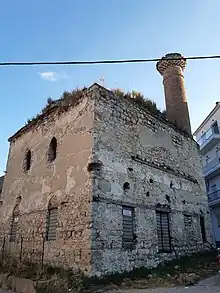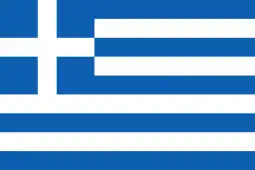| Kursum Mosque Κουρσούμ Τζαμί | |
|---|---|
 View of the mosque | |
| Religion | |
| Affiliation | Islam |
| Region | Western Macedonia |
| Year consecrated | Around 16th century |
| Status | Closed |
| Location | |
| Municipality | Kastoria |
| Country | Greece |
 Shown within Greece | |
| Geographic coordinates | 40°31′13.3″N 21°15′55.3″E / 40.520361°N 21.265361°E |
| Architecture | |
| Style | Ottoman architecture |
| Specifications | |
| Dome(s) | 1 |
| Minaret(s) | 1 (half-ruined) |
The Kursum Mosque (Greek: Κουρσούμ Τζαμί, Turkish: Kurşunlu Camii) of Kastoria is a historical Ottoman-era mosque in the town of Kastoria, Western Macedonia, Greece. It is mostly in a ruinous state as little renovation work has been done. It is not open for worship. It took its name from a Turkish word meaning lead, as its dome is covered with lead.
Description
Kursum Mosque is located near the old center of the city, on Mitropoleos Street. During Ottoman times, Kastoria had a total of seven mosques; Kursum Mosque is the only surviving out of those seven, in a bad condition.[1]
It is difficult to date the exact timeframe it was built, but it is speculated that it was built in the 16th century. Kursum Mosque was the most prominent mosque of the town and it has been argued that it was erected on the site of a previous Byzantine church, which in turn was erected on the site of a pagan temple from ancient times.[2][3]
It was for about 350-370 years a place of worship until Kastoria was annexed by Greece during the Balkan Wars, whereupon it ceased to function as a mosque. and then it was declared by the Greek State as a protected monument in 1924. The first library of the town of Kastoria was housed inside the mosque for some years beginning in 1925 and then it functioned as a warehouse of antiquities for many decades until recently. Thus, it is the only one that avoided being razed to the ground, as it was of some use, while the other six Ottoman mosques of Kastoria were demolished sooner or later, even though they had all been declared preserved monuments as well.[1]
Left unattended and with little restoration for years, the mosque is mostly ruined. Only the lower half of the minaret is preserved, covered in plant life.[1]
In 2016, three post-graduate students chose Kursum Mosque as the subject of their obligatory thesis within the interdepartmental postgraduate program "Protection, maintenance and restoration of cultural monuments" of the Polytechnic School of the Aristotle University of Thessaloniki. This earned strong reactions from the municipal council of Kastoria, who opposed any talks of restoration works claiming that there was no need as Kastoria no longer had any Muslim communities and that no mosque should be restored in Greece while there were talks in Turkey of converting Hagia Sophia into a mosque.[1][4][lower-alpha 1]
See also
Notes
- ↑ Hagia Sophia was converted into a mosque in 2020, four years after the incident.
References
- 1 2 3 4 "Το τζαμί της Καστοριάς και η ιστορία του" [Kursum Mosque of Kastoria and its history]. fouit.gr (in Greek). May 11, 2019. Retrieved November 5, 2022.
- ↑ Tsamisis 1949, p. 173.
- ↑ Moutsopoulos 1973, p. 404.
- ↑ "Το Κουρσούμ Τζαμί δίχασε την Καστοριά" [Kursum Mosque divided Kastoria]. archaiologia.gr (in Greek). February 22, 2016. Retrieved November 5, 2022.
Bibliography
- Tsamisis, Pantelis (1949). Η Καστοριά και τα μνημεία της [Kastoria and its monuments] (in Greek). Τύποις Ι. Λ. Αλευρόπουλος.
- Moutsopoulos, Nikolaos (1973). Καστοριά. Ιστορία – Μνημεία – Λαογραφία [Kastoria: History-Monuments-Folklore] (in Greek). ΕΕΠΣΑΠΘ.
External links
 Media related to Kursum Mosque at Wikimedia Commons
Media related to Kursum Mosque at Wikimedia Commons

